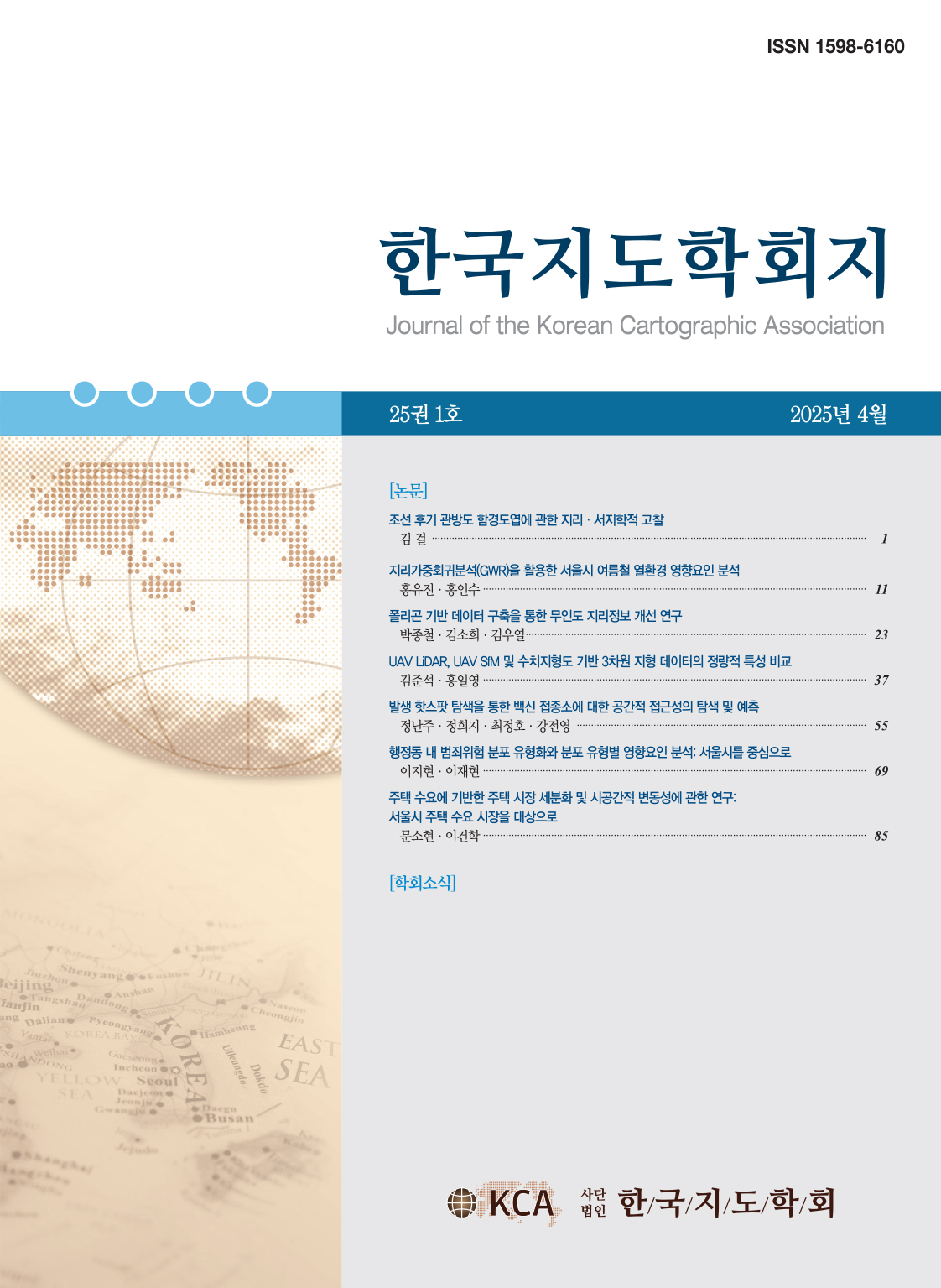Research Article
Abstract
References
Information
Alley business districts are important market areas to secure retail and commercial marketing competitiveness and stability, most of which has been vulnerable to external shocks, including the COVID-19 pandemic. While, most research studies in South Korea have focused on cases within large cities and high-street business districts such as Seoul and several large-sized cities in Kyuunggi province, few studies have attempted to delineate alley business district on a set of street boundaries in small and medium-sized cities where one-person business owners and self-employed subcontractors, in particular, have been suffered. This study has two main objectives: delineating spatial extents and classifying district types of the alley business districts suitable for small and medium-sized cities in Korea. This study delineates spatial extents using GIS-based data handling and processing techniques with the data sets of individual store coordinates and ‘Gil’ type of the road names available through small enterprise, commercial, and road name address databases. Using the delineating spatial extent and classification results, this study produced alley business districts map of Cheongju city and examined the spatial characteristics of the four types of districts in the city. Finally, we expect that the findings of this study — alley(‘Gil’)-based catchment areas and classification of the alley businesses — may be used as core data and contribute adequately to predicting street-scaled markets and businesses. Besides, the results of this study can serve as a realistic starting point for policymaking to revitalize alley business districts with the understanding and prediction of its district changes.
골목상권은 상권 경쟁력 확보와 상권 내 점포의 안정적 운영 측면에서 중요한 공간적 영역으로 인식되어 왔고, 코로나 이후 상권 측면에서도 골목상권은 중요한 연구 대상으로 제기되고 있다. 지금까지 골목상권 연구는 서울시와 같은 대도시 골목상권 을 중심으로 진행되어 왔다. 이에 본 연구는 청주시를 사례로 소상공인 개별 데이터와 GIS 기법을 활용하여 중소도시에 적합한 골목상권 영역 설정 방법을 제안하고, 이를 토대로 골목상권 유형을 분류하고 주요 특성을 살펴보고자 하였다. 골목상권 영역 설정은 데이터 전처리 과정을 거쳐, 생활밀착형 업종 점포를 추출하고 도로명주소 내 ‘길’ 단위 점포를 추출하여 골목상권 영역을 설정하였다. 골목상권 유형은 개폐업률에 의해 성장형-순환형-정체형-쇠퇴형으로 분류하고, 네 유형의 골목상권 분포를 지도화하고 상권별 주요 특성을 살펴보았다. 본 연구에서 제안한 골목상권 영역 설정 방법과 유형 분류는 앞으로 세밀한 골목상권의 이해와 공간 단위에서의 골목상권 변화에 활용되기를 기대한다. 또한 본 연구의 성과는 상권의 이해와 변화 예측을 넘어 골목상권 활성화를 위한 정책 수립의 출발점이 될 수 있다.
- 강기춘, 2012, “골목상권이 살아야 풀뿌리 경제가 살아난다,” 제주특별자치도지, 116, 219-225. 10.1097/ALN.0b013e31823c7e81 22185881
- 강현모・이상경, 2019, “시계열 군집분석과 로지스틱 회귀분석을 이용한 골목상권 성장요인 연구,” 한국측량학회지, 37(6), 535-543.
- 구형모, 2020, “서울 상업 젠트리피케이션 진행 단계의 시・공간 분포 탐색: 커피전문점의 밀도 변화를 중심으로,” 한국지도학회지, 20(1), 117-129. 10.16879/jkca.2020.20.1.117
- 김감영, 2016, “주택시장지역 구획을 위한 공간 최적화 모형,” 한국지도학회지, 16(1), 53-65. 10.16879/jkca.2016.16.1.053
- 김명진, 2012, “A heuristic approach with new contiguity checking method to congressional redistricting,” 한국지도학회지, 12(3), 81-94.
- 김범식・최봉, 2012, 「서울시 영세소매업의 특성분석과 정책방향」, 서울연구원.
- 김종규, 2016, “골목에 대한 장소적 고찰: 도시의 미래를 위한 한 제언,” 인문과학, 63, 35-65.
- 김종근・주승민, 2016, “층별 효용비율을 통한 상권 특성 분석과 동향 탐색,” 한국지도학회지, 16(2), 105-114. 10.16879/jkca.2016.16.2.105
- 김현철・이승일, 2019, “서울시 골목상권 매출액에 영향을 미치는 요인에 관한 연구,” 서울도시연구, 20(1), 117-134.
- 남윤미, 2017, “국내 자영업의 폐업률 결정요인 분석,” BOK 경제연구, 제2017-5호
- 모종린, 2017, 「골목길 자본론」, 파주: 다산북스.
- 박주영, 2018, “골목상권 활성화 생태계 조성을 위한 지역 소상공인 정책 거버넌스,” 중소기업정책연구, 3(2), 1-34.
- 박찬익・김현정・정창무, 2021, “서울시 ‘~리단길’ 골목상권 상가거래가격에 영향을 미치는 요인 분석,” 부동산분석, 7(3), 119-134. 10.30902/jrea.2021.7.3.119
- 신용재・김종인, 1990, “도시주택지 골목공간의 장소적 의미,” 대한건축학회 학술발표대회 논문집, 10(2), 277-278.
- 유현지, 2021, “코로나19와 서울시 골목상권의 매출액 영향요인에 관한 연구,” 한국지역개발학회지, 33(3), 45-75.
- 이기훈・이수기・천상현, 2018, “서울시 상업 젠트리피케이션 발생 주거 지역의 입지적 요인과 변화특성 분석,” 지역연구, 34(1), 31-47.
- 이영리・신명호・홍세희, 2015, “생존분석을 적용한 장애인 자영업자 이탈 및 영향요인 분석,” 조사연구, 16(3), 25-44.
- 이석현, 2014, “골목시장의 공간 활성화에 대한 상인과 이용자 의식 조사,”
Archives of Design Research , 27(3), 133-151. - 임수명・김동춘・이승일, 2020, “서울시 골목상권 특성이 일반음식점의 성장단계별 생존에 미치는 영향 연구: 구조방정식 모형을 통한 집적경제의 매개효과 검증,” 부동산학연구, 26(3), 45-62. 10.19172/KREAA.26.3.3
- 정동규・윤희연, 2017, “발달상권과 골목상권에 위치한 음식점의 생존과 폐업 비교,” 대한건축학회논문집, 33(3), 57-68. 10.5659/JAIK_PD.2017.33.3.57
- 정진호・윤두원・성순아・황희연, 2015, “도시재생 상권 활성화 프로그램 효과 분석,” 국토지리학회지, 49(1), 15-25.
- 허준영・이병민, 2017, “문화적 도시재생으로서 골목문화 형성에 나타난 주요 특성 연구: 마을 공동체를 중심으로,” 문화콘텐츠연구, 9, 133-157. 10.34227/tjocc.2017..9.133
- 황동현・고경석・박상준・김완수, 2018, “빅데이터 기반 골목상권 영역설정 방법론 개발,” 한국정보전자통신기술학회 논문지, 11(6), 784-792.
- Batty, M., 2008, The size, scale and shape of cities,
Science , 319(5864), 769-771. 10.1126/science.1151419 18258906 - Berry, B.J.L., 1967,
Geography of Market Centers and Retail Distribution , Englewood Cliffs, New Jersey: Prentice-Hall. - Hughes, C. and Jackson, C., 2015, Death of the high street: Identification, prevention, reinvention,
Regional Studies, Regional Science , 2(1), 237-256. 10.1080/21681376.2015.1016098 - Birkin, M., Clarke, G. P., and Clarke, M., 2017,
Retail Location Planning in an Era of Multi-channel Growth , London: Routledge. 10.4324/9781315605937 28217786 - Mackaness, W. A. and Chaudhry, O. Z., 2011, Automatic classification of retail space from a large scale topographic database,
Transactions in GIS , 15(3), 291-307. 10.1111/j.1467-9671.2011.01259.x - Dolega, L., 2021, Spatial extent and classification of retail agglomeration, in Birkin, M., Clarke, G., Corcoran, J., and Stimson, R., eds.,
Big Data Applications in Geography and Planning , Cheltenham, UK: Edward Elgar, 93-101. 10.4337/9781789909791.00013 - Pavlis, M. and Singleton, A., 2018, Retail areas and their catchments, in Longlye, P.A., Singleton, A., and Cheshire, J., eds.,
Consumer Data Research , London, UK: UCL Press, 41-51. 10.2307/j.ctvqhsn6.6 - Singleton, A.D., Dolega, L., Riddlesden, D., and Longley, P., 2016, Measuring the spatial vulnerability of retail centres to online consumption through a framework of e-resilience,
Geoforum , 69, 5-18. 10.1016/j.geoforum.2015.11.013 - Thurstain-Goodwin, M. and Unwin, D., 2000, Defining and delineating the central areas of towns for statistical monitoring using continuous surface representations,
Transactions in GIS , 4(4), 305-317. 10.1111/1467-9671.00058 - Wrigley, N. and Dolega, L., 2011, Resilience, fragility, and adaptation: New evidence on the performance of UK high streets during global economic crisis and its policy implications,
Environment and Planning A: Economy and Space , 43(10), 2337-2363. 10.1068/a44270 - Wrigley, N. and Lambiri, D., 2015.
British High Streets: from Crisis to Recovery? A Comprehensive Review of the Evidence , University of Southampton, Southampton, https://great-british-high-street.s3.eu-west-2.amazonaws.com/website-assets/pdf/GBHS-British-High-Streets-Crisis-to-Recovery.pdf (2022.3 검색) - 국립국어원 표준국어대사전, https://stdict.korean.go.kr/main/main.do(2022.3 검색)
- 지방행정 인허가 데이터개방, https://www.localdata.go.kr/(2022.3 검색)
- Publisher :The Korean Cartographic Association
- Publisher(Ko) :한국지도학회
- Journal Title :Journal of the Korean Cartographic Association
- Journal Title(Ko) :한국지도학회지
- Volume : 22
- No :1
- Pages :69-83
- DOI :https://doi.org/10.16879/jkca.2022.22.1.069



 Journal of the Korean Cartographic Association
Journal of the Korean Cartographic Association





